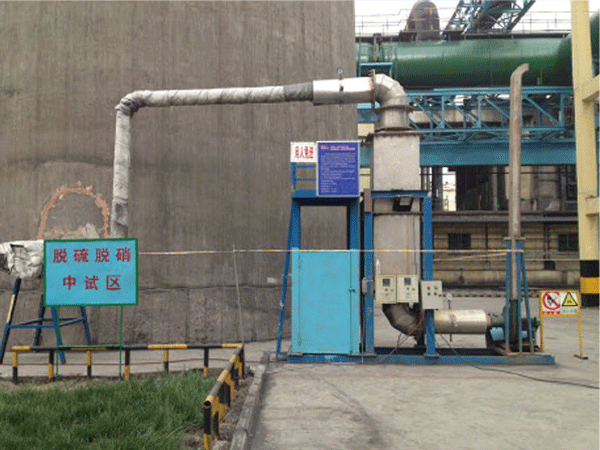What is low temperature denitration catalyst
Publishdate:2022-10-18 Views:92
The function of low-temperature denitration catalyst mainly depends on its composition. Different denitration catalysts need different components. The main components of common SCR denitration catalyst: the main components of SCR denitration catalyst are titanium dioxide, vanadium pentoxide, tungsten trioxide, etc. Titanium dioxide in SCR denitration catalyst is a substance, while vanadium pentoxide and tungsten trioxide are slightly toxic substances, which are harmful for long-term inhalation. The catalytic reduction flue gas denitration technology is selected, and the SCR denitration catalyst is generally arranged between the economizer and the air preheater.

Monazite low-temperature SCR catalyst is a catalyst independently developed by our company. It is a new type of intellectual property SCR light catalyst with low heat capacity and high strength ceramic honeycomb as the carrier. The surface is coated with transition layer and high activity SCR catalyst coating, and the most active component of catalyst coating v-w-ti. The catalyst is attached to the surface of the carrier using a special coating process.
The catalyst has excellent low-temperature activity, thermal shock resistance, poisoning resistance and high specific surface area. The excellent material characteristics can greatly shorten the heating time of the catalyst, rapidly heat the ignition temperature of the catalyst and produce SCR reaction. Under high NOx concentration and space velocity, the NOx removal efficiency remains above 90%, and the ammonia escape rate is low. According to the application requirements and exhaust gas conditions, the shape, size and pore density of the catalyst are reasonably designed to ensure the utilization rate of the catalyst.
1. the denitration catalyst operates at a high temperature within a certain range
320-360 ℃. Not more than 400 ℃, otherwise, the catalyst will be burned.
2. reduce material waste
Due to the function of the catalyst itself, it can quickly catalyze the reactants, which improves the rational utilization of reactants.
3. improve enterprise efficiency
The function of catalyst is to accelerate the chemical reaction and ensure that the material state remains unchanged.
4. reduce production costs
In the production of industrial enterprises, there is a large number of production every day, which also has a great demand on the total amount of catalysts. The regeneration and utilization of catalyst can reuse the temporarily inactive catalyst and reduce the procurement cost of enterprises in this regard.
5. it can save a lot of time
Low temperature denitration catalyst is a catalyst that can accelerate the reaction rate of substances. As long as a small amount of catalyst is added in the production process, the reaction rate can be accelerated.
6. comply with national environmental protection policies
Since the state has strict standards for the emission of nitrogen oxides, these manufacturers of nitrogen oxides will use low-temperature denitration catalysts to achieve denitration effect.
The function of low-temperature denitration catalyst mainly depends on its composition. Different denitration catalysts need different components. The main components of common SCR denitration catalyst: the main components of SCR denitration catalyst are titanium dioxide, vanadium pentoxide, tungsten trioxide, etc. Titanium dioxide in SCR denitration catalyst is a substance, while vanadium pentoxide and tungsten trioxide are slightly toxic substances, which are harmful for long-term inhalation. The catalytic reduction flue gas denitration technology is selected, and the SCR denitration catalyst is generally arranged between the economizer and the air preheater.

Monazite low-temperature SCR catalyst is a catalyst independently developed by our company. It is a new type of intellectual property SCR light catalyst with low heat capacity and high strength ceramic honeycomb as the carrier. The surface is coated with transition layer and high activity SCR catalyst coating, and the most active component of catalyst coating v-w-ti. The catalyst is attached to the surface of the carrier using a special coating process.
The catalyst has excellent low-temperature activity, thermal shock resistance, poisoning resistance and high specific surface area. The excellent material characteristics can greatly shorten the heating time of the catalyst, rapidly heat the ignition temperature of the catalyst and produce SCR reaction. Under high NOx concentration and space velocity, the NOx removal efficiency remains above 90%, and the ammonia escape rate is low. According to the application requirements and exhaust gas conditions, the shape, size and pore density of the catalyst are reasonably designed to ensure the utilization rate of the catalyst.
1. the denitration catalyst operates at a high temperature within a certain range
320-360 ℃. Not more than 400 ℃, otherwise, the catalyst will be burned.
2. reduce material waste
Due to the function of the catalyst itself, it can quickly catalyze the reactants, which improves the rational utilization of reactants.
3. improve enterprise efficiency
The function of catalyst is to accelerate the chemical reaction and ensure that the material state remains unchanged.
4. reduce production costs
In the production of industrial enterprises, there is a large number of production every day, which also has a great demand on the total amount of catalysts. The regeneration and utilization of catalyst can reuse the temporarily inactive catalyst and reduce the procurement cost of enterprises in this regard.
5. it can save a lot of time
Low temperature denitration catalyst is a catalyst that can accelerate the reaction rate of substances. As long as a small amount of catalyst is added in the production process, the reaction rate can be accelerated.
6. comply with national environmental protection policies
Since the state has strict standards for the emission of nitrogen oxides, these manufacturers of nitrogen oxides will use low-temperature denitration catalysts to achieve denitration effect.




